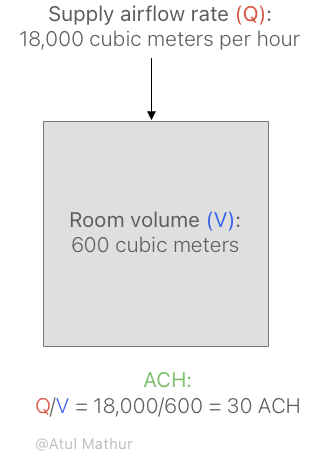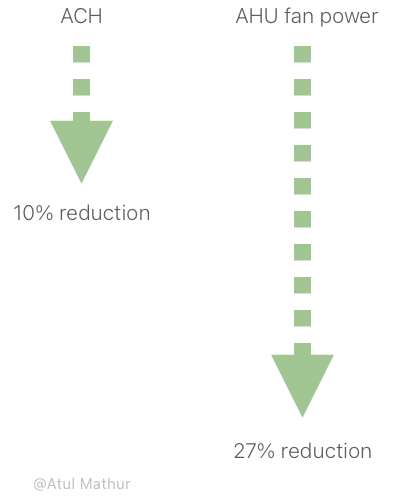How to Save Energy by Trimming Cleanroom Air Changes (ACH)
Whenever the attention shifts to energy conservation in an operating biopharma facility, the discussion obviously starts with the elephant outside the room: the HVAC system. And for a good reason! The HVAC family includes energy guzzlers like chillers, pumps, cooling towers, Air Handling Units (AHUs), and fans, who all tirelessly work 24x7x365 to provide GMP conditions inside the cleanrooms. No wonder, HVAC alone accounts for about 50-60% of the overall site-wide energy consumption.

Potentially, the HVAC energy-saving menu includes a wide range of options, from big things like energy-efficient chillers, high-efficiency motors, and VFD-driven cooling towers to energy optimization software systems to using low-drop HEPA filters, reducing fresh air quantities and raising chilled water temperature. With so many options, the obvious question is: What are the low-hanging fruits to pluck?
One of those few opportunities that are promising, practical, and do not require massive upfront investments is Air Changes or ACH reduction. Many existing biopharma facilities are waking up to the idea of trimming down the ACH in the cleanrooms to reap decent energy savings.
This post lays out a broad roadmap for extracting energy savings out of ACH reduction opportunities by addressing the following key questions:
- What’s ACH and why it matters?
- Why is ACH reduction a ripe fruit to pluck?
- What’s the first step towards making it happen?
1. What’s ACH and why it matters?
As the term indicates, Air Changes or ACH is nothing but an indication of how many times (in an hour) air inside a room gets changed with cool and clean filtered air. To get it experientially, imagine a closed room where the HVAC is down. Won’t the air inside such a room be totally stale and stagnant? Now think of the same room with the HVAC working and the complete room air being replaced with cool and clean air 30 times an hour. Not difficult to imagine, how the environmental conditions (temperature, humidity, and cleanliness) will be totally different in both cases.
Calculating ACH for a room is easy: It’s simply the rate of supply air (Q) flowing into a room divided by the room volume (V). So if you’re supplying 18000 cubic meters of air per hour into a room of 200 sq.m area and 3 m height, the ACH for this room is 18000/(200 x 3) = 30 ACH.

But going beyond the basics, the discussion around ACH won’t be complete, unless we ask:
- Is ACH governed by any GMP regulations?
- What are the general guidelines on ACH for biopharma cleanrooms?
- How the cleanroom environmental conditions are impacted by ACH?
1.1 ACH and GMP regulations
Is minimum ACH governed by GMP regulations? The answer is both yes and no.
The USFDA’s “The Sterile Drug Products Produced by Aseptic Processing — Current Good Manufacturing Practice” says:
For Class 100,000 (ISO 8) supporting rooms, airflow sufficient to achieve at least 20 air changes per hour is typically acceptable. Significantly higher air change rates are normally needed for Class 10,000 and Class 100 areas.
In contrast, EU GMP regulations do not include any such minimum ACH requirements for sterile production.
So ACH is a kind of grey zone when seen from the regulatory standpoint.
1.2 ACH and industry guidelines
Though not a regulatory body, the International Society of Pharmaceutical Engineering (ISPE) does provide guidelines on ACH for Grade B, C, and D cleanrooms:
- Grade D & CNC: 6 to 20 AC/hr
- Grade C: 20 to 40 AC/hr
- Grade B: 40 to 60 AC/hr
As you can see, ISPE is careful not to mention a single number but a range. In alignment with the ISPE recommendations, most biopharma companies follow their own internal guidelines that are more specific. For example, in my recent Fill and Finish facility project, the minimum ACH required for grades D and C were 20 and 30 ACH respectively.
Let’s move to the last piece: How does ACH affect the environmental conditions inside a cleanroom?
1.3 ACH and environmental conditions
Brace for a counterintuitive shock:
Unlike what most people may think, ACH itself is not important for room particle counts. Instead of ACH, the level of particles inside a cleanroom depends on the following three parameters: (1) particle generation rate within the room (people, equipment, process), (2) supply airflow rate (Q in the example above), and (3) how well room and supply air get mixed up.
If you’ve two rooms with the same three parameters mentioned above but with different ACH (due to different room volumes), you would have the same particle counts in both rooms.
So if it doesn’t directly affect the particle counts, why does ACH matter?
ACH enjoys a direct relationship with a critical GMP parameter: Room recovery. As the name suggests, room recovery is a parameter to measure how fast a cleanroom can recover to a required cleanliness level after being briefly exposed to airborne particulate challenge. In other words, it’s the ability of the HVAC system to “clean up” the room by eliminating particles. EU GMP guidance value for the recovery time is 15-20 minutes.

For example, recovery for a Grade C room is measured by injecting 100 times its allowable 0.5-micron particle count at rest (i.e., 352,000 x 100 particles/cubic meter)—and testing if the room falls back to below 352,000 within 15-20 minutes. ACH is important because it affects this recovery time: If you reduce ACH, the recovery time goes up.
To conclude, ACH may not be directly playing a role in maintaining room particle counts, but it does directly impact room recovery, which is a GMP requirement.
2. Why is ACH reduction a ripe fruit to pluck?
Why operating facilities are eyeing energy savings through ACH reduction? Basically, for two primary reasons:
2.1 Fan energy versus airflow
At the heart of energy savings from ACH reduction are the following two well-known fan laws:
- Q ⍺ N: Fan airflow is proportional to the fan speed.
- P ⍺ (NxNxN): Fan power is proportional to the cube of the fan speed.
In practical terms, if during ACH reduction exercise, you trim down Air Handling Unit (AHU) fan airflows by reducing its speed by 10% or 20%, the AHU power consumption could be down by nearly 27% or 49% respectively. This exponential relationship is great for energy saving.

2.2 Excessive ACH
Industry-wide, there is a growing realization that the legacy ACH numbers used for the last so many years are actually overkill. Do we need, for example, 30 or 35 for Grade C or 20 ACH for Grade D?
The slowly emerging answer across the industry is No! Although there is loads of information available on this subject, I will cite the following two papers to underscore this important point:
- Paper titled “Ensuring the air supply rate in a cleanroom complies with the EU GGMP and ISO 14644-3 recovery rate requirements” by W Whyte, N Lenegan and T Eaton. Published in the Clean Air and Contamination Review, this paper shows that Grade B can operate around 27 ACH while Grade C at 13 ACH.
- Paper titled “Air Change Rate Reduction during Operation: Success at Roche/Genetech” by Behzad Torabifar & Geoffrey Wing. Published in Pharmaceutical Engineering, the paper shows how they successfully turned down ACH for ISO 8 rooms from 25 ACH to 12-16 ACH and for ISO 7 rooms from 48 ACH to 28 ACH.
When you combine the fan laws with the growing realization that most facilities are overdesigned, the case for ACH reduction becomes stronger.
The right way for an existing facility aiming for ACH reductions would not be to jump to some arbitrary numbers but to conduct a detailed engineering study to understand its own unique situation. And that brings us to the final point of this post.
3. The first step: Engineering study
ACH reduction is not just an HVAC issue; it involves operations, quality, GMP, automation, and more. That’s why the path to energy savings starts with investment in a comprehensive study to understand the feasibility and impact of an ACH reduction project. The key pieces to include in such a study are as shown in the diagram below.

To dive even deeper, here are some points that must be addressed in the study.
Facility
- Rooms, classifications, usage (open or closed process, no production-related activity)
ACH
- Design ACH of each room
- Actual ACH of each room (fresh measurements)
- Proposed reduction in ACH based on both theoretical calculations and measured facility data
GMP conditions
- Particle counts (at rest and in operation): Grade B, C & D rooms (fresh measurements)
- Room recovery (fresh measurements)
- Temperature and relative humidity trends for two weeks
- Room pressure trends for two weeks
HVAC system
- Air Handling Units: Fresh measurements of supply, return, and fresh airflows
- Affected dampers, constant air volume (CAV) boxes, constant air volume (VAV) boxes
- Modifications required in the field: Existing & new set points
- Any new equipment to be purchased
Automation
- Impact on automation systems
- Current set points and proposed new set points
Energy savings
- Current energy consumption (annual and one-month trend and figures)
- Potential energy savings
Schedule
- Projected duration and schedule of the project
- Interface with the ongoing operations
Risks
- Technical, physical, safety, GMP risks, and mitigation measures
Costs & returns
- Cost of executing the project
- Value of energy savings in dollars
- Return On Investment (ROI)
A study covering so many issues looks like a tall order, but it is necessary to set the foundation for a smooth transition to lower ACH in an operating facility. Shortcuts can be costly here!
Notoriously, HVAC consumes a big chunk of energy in existing operations. Paradoxically, it also offers a number of opportunities to save energy and contribute towards sustainability. ACH reduction is one sure way to shrink the size of your HVAC energy elephant.
Upcoming training…
Note: To know more about this training, please download the slides.
